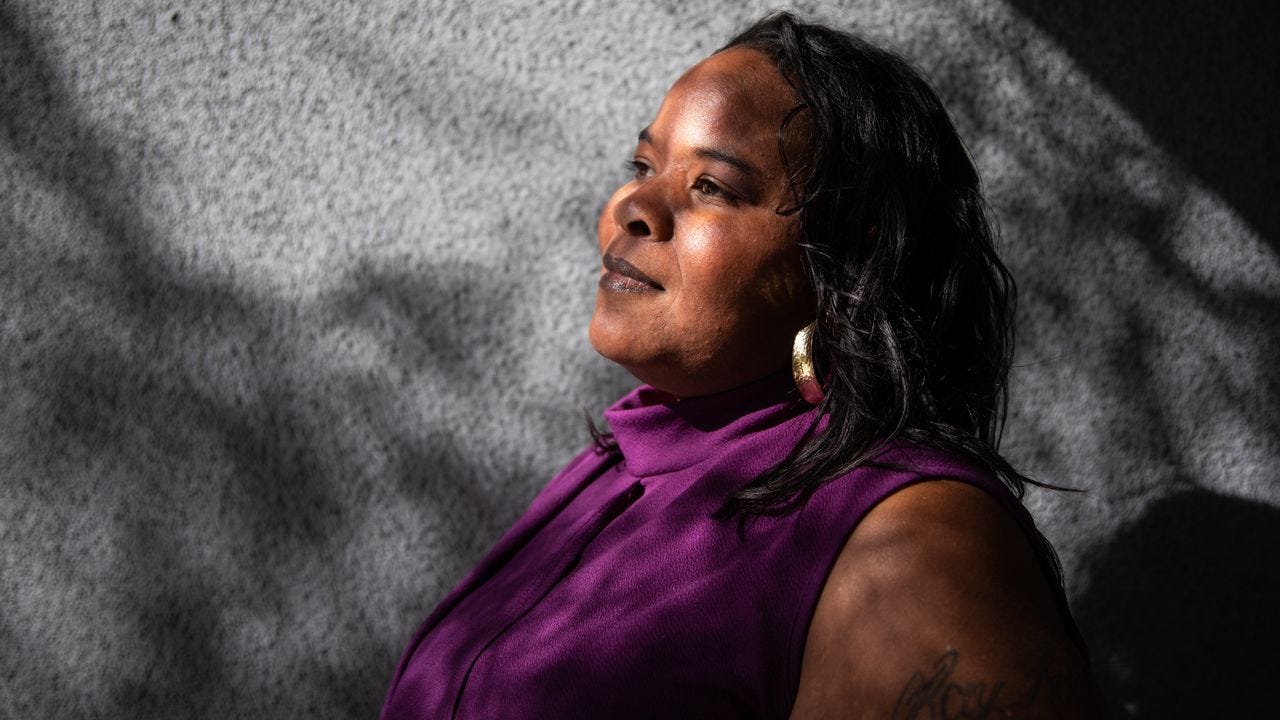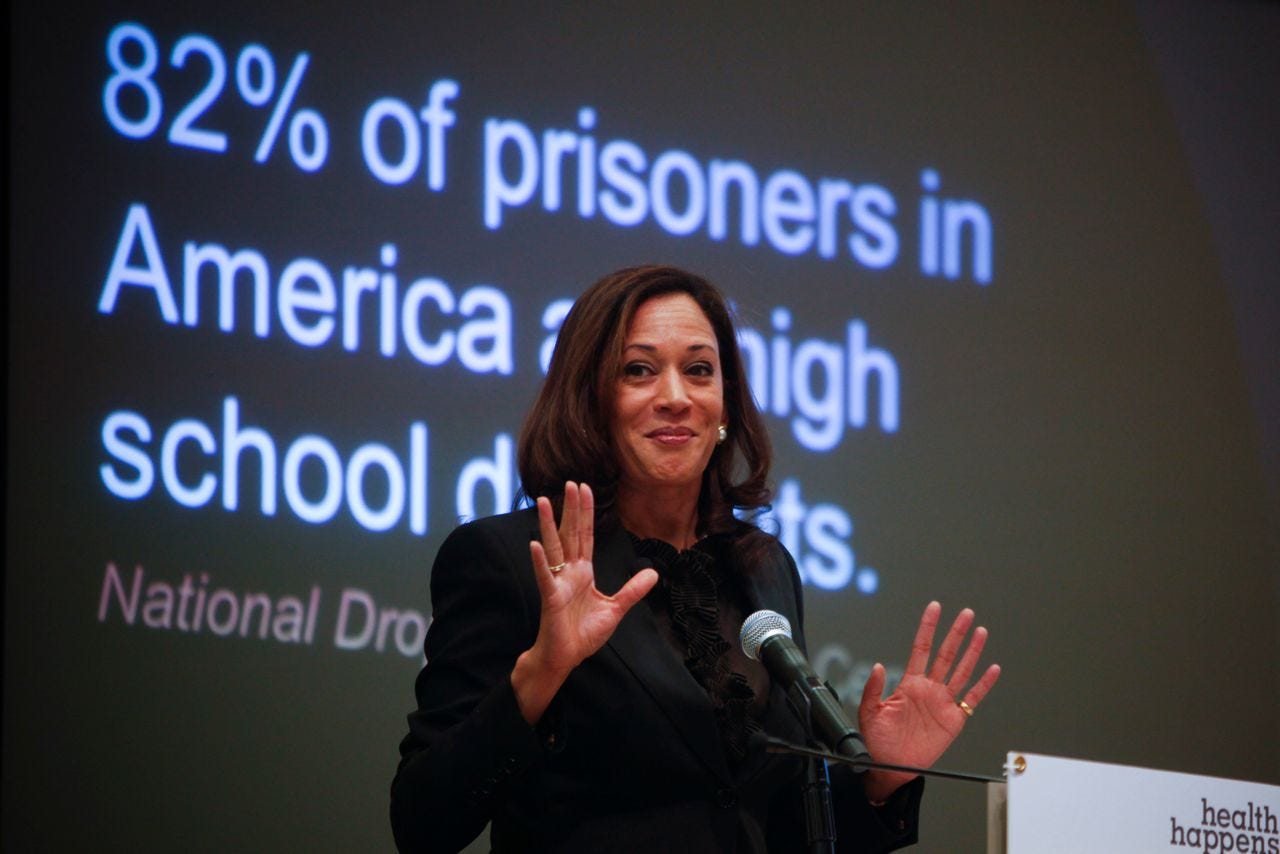WELCOME TO TRUMPISTAN
Chronicle of a Defeat Foretold

+ What does history repeat itself as after it does farce?
+ Kamala Harris proved too cowardly even to address her supporters Tuesday night, as her loss to Trump became more and more inevitable. But what could she really say? She couldn’t honestly say she’d run a vigorous campaign that championed the poor, the downtrodden, and the voiceless or that she’d fought for peace, and human dignity, and to fix an unraveling climate. I’d be really interested to hear her say what she thought her campaign was all about, but even Harris probably couldn’t have pinpointed the purpose or the meaning of her doomed run…
+ From the outside, Harris’s entire campaign seemed to be about saving an economic system (neoliberalism) that she described falsely as “democracy,” which isn’t working for large segments of both the political left and right; at the same time she and Biden were flouting an international system of laws in order to arm and finance a genocide in Gaza. The hypocrisies were too transparent to sustain.

+ This was a fatal moment in the friendly confines of the Stephen Colbert Show around the time that her post-convention/debate bounce began to deflate and she never got any better…
Stephen Colbert: “Under a Harris administration, what would the major changes be and what would stay the same?”
Harris: “Sure. Well, I mean, I’m obviously not Joe Biden. So that would be one change. But also I think it’s important to say with 28 days to go, I’m not Donald Trump.”
+ Like Hubert Humphrey, Harris was saddled with an unpopular war (a war & a genocide in her case) that her own boss was waging. Humphrey tried to break from LBJ on Vietnam but too late. Harris never did.
+ Harris’s stubborn refusal to separate herself from Biden to any degree went so far as to turn her campaign over to his campaign staff, the same brilliant strategic minds that had him trailing Trump by 10 to 15 points in July…
+ Harris had very different policies when she ran against him in 2016, maybe she should’ve stuck with a few of them, instead of saying stuff like her beliefs haven’t changed but her position on fracking/national health care/the border/ have….
+ In what was obviously going to be a “change” election, when Harris had the chance to differentiate herself from Biden, she said there wasn’t a “thing she could think of” she’d do differently…
+ Harris’s flip-flop on fracking is emblematic of her entire campaign, a relatively minor issue that gave devastating insight into her vacuous political character. She could never explain it because the only explanation was pure political calculation (and a bad one). She was willing to invalidate her climate policy to court a few thousand votes in Pennsylvania. It was the equivalent of Hillary telling Goldman Sachs she had one policy in public and another in private. But even more inept. How could you make the campaign about honesty & trust, once you’d shown yourself to be dishonest and untrustworthy on an issue you’d described as being an existential threat to human life on earth?
+ Harris sold out the climate movement (and the climate) and still lost Pennsylvania…
+ Harris losing Pennsylvania almost ensures that the Democrats will turn to Josh Shapiro as their champion in 2028 and won’t reverse course on their blind support of Israel.
+ Maybe in Harris’s case she’d’ve had a better shot at winning Wisconsin if she skipped it like Hillary. It could be the more they saw of her, the less there was to see…

+ Exit Poll in Wisconsin: Trump doubled his support among Black voters. He now has about 20% of the Black vote, compared to 78% for Harris. Four years ago, Trump won only about 8% of Black voters in the Badger State.
+ John Kerry lost in part because his “Ready to Serve” campaign emphasized his military career as the war in Iraq unraveled. Harris played up her role as a hard-ass prosecutor at a time of record police shootings–no wonder her support with Black and Hispanic men collapsed.
+ As I wrote in my column two weeks ago, Harris’ strategy to use Liz Cheney as a surrogate to win the mythical Haley voters when Haley herself was out campaigning for Trump was doomed to fail. And fail it did, spectacularly. Recall that when Cheney left office, he was one of the most universally reviled figures in American history, with an approval rating of 13%.

+ The Harris campaign’s messaging was so bad that they lost to Trump on the issue she hit the hardest, his MAGA movement being a threat to democratic values…

+ The Cheney gambit didn’t help her with independents. In Pennsylvania, independents went 50-44 for Donald Trump.
+ If any good comes out of this disaster, it would be driving the final nails in the coffins of the Clintons, Bidens, Bushes, Obamas, and Cheneys… It won’t. They’ll all be back in one manifestation or another. The one thing we can count on is that no lessons will be learned from this debacle. The Democrats lost to Trump the same way they did in 2016, only worse.
+ Ryan Grim: “The Cheneys have now stolen two elections from Democrats, but you can’t really blame them for the second.”
+ Sending NAFTA Bill Clinton to scold Arab-American voters in Michigan (of all places!) and Obama to harangue black men in Pennsylvania during the last week of the campaign seems to have gone over well…
+ The Harris campaign refused to allow one anti-genocide speaker at their convention, even one willing to give a tame, non-confrontational, pre-approved speech.
+ Harris lost south Dearborn, Michigan, a 90% Muslim area that Biden won with 88% of the vote four years ago…
Trump: 46.8%
Harris: 27.68%
Stein: 22.11%
+ Dr. Gassan Abu Sitta: “Gone is a genocidal president too hypocritical to admit it. And in comes a genocidal president who wears it as a badge of honor.”
+Harris made little effort to court the youth vote and, at times, seemed to actively disdain it. They repaid her in kind. CBS News Exit Poll in Michigan: “Younger voters (age 18-29) are narrowly going for Trump right now…This deficit for Harris is largely due to younger men in Michigan who are more for Trump.”
+ Around 67% of voters rated the economy as “not so good/poor.” Dissatisfaction with the post-pandemic economy has been evident for at least two years. But Biden and Harris did nothing to address the core issue of the election except tell people that the economic pain they were feeling was psychosomatic.
+ According to the AP’s Votecast, Union members voted for Harris 57-39. Maybe the Harris campaign should have featured more Shawn Fain and less Liz Cheney and Mark Cuban.
+ Households $100,000 and under…
2020: Biden 70%, Trump 29%
2024: Harris 48%, Trump 49%
+ Both Harris and Biden turned their backs on the most successful and popular economic policies of the early Biden era in an attempt to convince the public the pandemic was over–even though COVID continued to sicken, kill and impoverish folks–all while Biden kept writing blank checks to Israel and Ukraine
+ Remember when the Democrats promised $2000 stimulus checks and then only delivered $1400? People living on the economic margins, as most of us were during the pandemic, have long memories….
+ Voters in the red state of Missouri voted to raise the statewide minimum wage to $15 by 2026 and guarantee paid sick days to workers. Nebraska voters also passed Initiative 436, giving workers the right to earn paid sick leave. Harris waited until the campaign’s last two weeks to call for a hike in the federal minimum wage.
+ Aside from Gaza and the economy, the Harris team seemed to totally misread the electorate, perhaps believing they could win on the gender gap (21 points) alone. They couldn’t. 71% of voters were White (up from 67% in 2020), 11% were Black (down from 13%), and 12% were Hispanic (slightly down from 13%. This “white surge” and “black/brown ebb” is at least in part because Harris didn’t give Blacks and Hispanics much of an affirmative reason to turn out to vote and many reasons to stay home.
+ Harris is no Claudia Scheinbaum…
Latino men, 2020: Biden 59%, Trump 36%
Latino men, 2024: Harris 45%, Trump 53%
+ Hidalgo County, Texas, is 92% Latino. Hilary Clinton won with 68.5%. Biden won with 58% of the vote. Harris and Trump are 50/50.
+ In 2016, HRC won Cameron County, Texas, which is 80% Hispanic, by 16%. Last night, with more than 95% of the vote counted, Trump was leading Harris 52% to 47%.
+ Ted Cruz won Latino voters by 6 points, according to NBC News exit polls. In his last race in 2018, Cruz lost Latinos by 29 points—a 35-point swing.
+ Some quarters expected Harris to have a shot at winning North Carolina. She didn’t. In fact, Trump won Anson County, North Carolina, which is 40% Black. This makes Trump only the second Republican to win this county since Reconstruction.

+ But it’s not just Hispanics and Black men. In NYC, with more than 95% of the vote in, Kamala Harris was polling at 67.8%. If that stands, it will be the worst performance for a Democratic Presidential candidate in the city since Dukakis in 1988…
+ Harris seems likely to lose the popular vote as well, which would relieve the Democrats of having to pretend to take action regarding the Electoral College.
+ The Democratic Senate candidates are running ahead of Harris by 1 to 3 percentage points, but they’ve already lost seats in WV and Ohio and are likely to lose Montana, as well, to a Republican who lied about being shot in Afghanistan.
+ Doug Henwood: “Tim Walz. Remember when he was a thing?”
+ Walz was a thing who was never let loose to do his thing…
+ Biden picking Merrick Garland as AG was the most self-defeating cabinet pick since Obama picked Tim Geithner to run Treasury and bail out the same bankers who’d screwed over the people who elected him.
+ In the end, Harris didn’t outperform Biden in a single county in the country.
+ Maybe they should’ve had a primary…?





